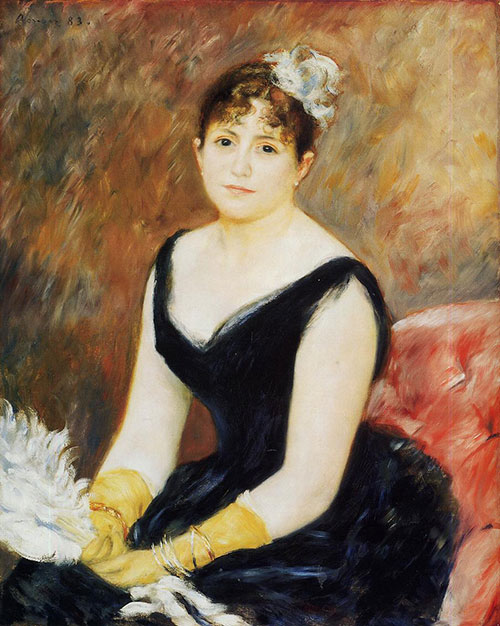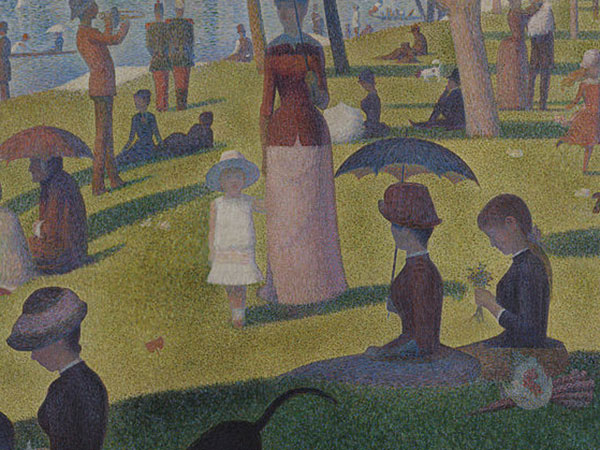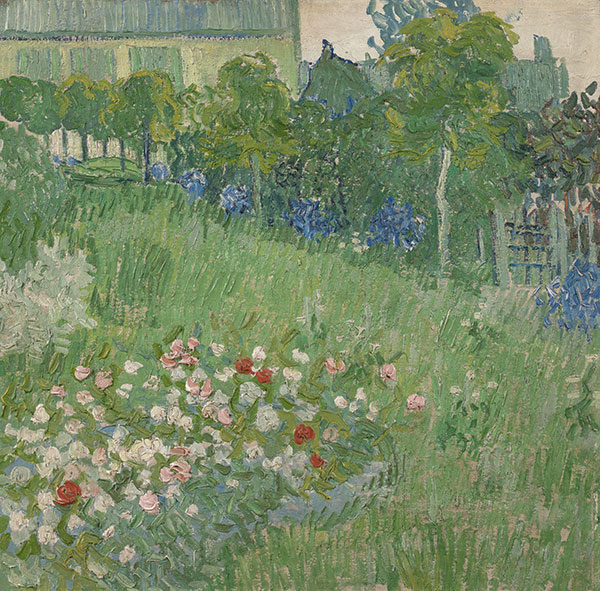Digital Restoration
Description
Pigments in a painting change with time and the degradation can lead to several undesirable effects such as bleaching, darkening, or colour change of the pigment. The varnish used to protect the painting layers can also significantly darken with age and change its structure in such a way that its light scattering becomes more pronounced (1).
Video: 'Turning Back Time with 3D Digital Restoration of Fine Art' by Versus Art
Procedure
The procedure for the digital restoration or digital rejuvenation of a painting consists of a thorough investigation of the changes undergone by the degraded pigments and then simulating the look of the painting in its original state using modern imaging tools.
The sequence of steps can be described as follows: One or several small areas in the painting where the pigment has deteriorated are chosen as reference. The spectral values of the deteriorated paint sample are measured and collected in one data set. The same procedure is then applied to an undeteriorated paint sample and the resulting data is stored in the second data set. Finally, an appropriate mathematical transformation is applied to the two data sets and the resulting function is used to replace the paint in the entire degraded area of the painting. Four different mathematical procedures for the transformation of degraded paint values to the values of the unchanged pigment have been described in reference (2).
Original Colours
In some cases, portions of the unchanged pigment can be found in areas of the painting protected from light and other influences such as areas of a painting covered by the frame. In such a case the faded or otherwise degraded colours in the painting can be digitally replaced by the colour values of the unchanged pigment. A nice and recent example of such a case is the work of the scientists at the Art Institute of Chicago and Northwestern University on digital restoration of Renoir’s painting The Portrait of Mme Léon Clapisson shown below under the “Examples of use”.
If no unchanged pigment can be found in the painting the degraded pigment mixture must be first identified. Fresh samples of the same pigment mixture are then prepared and their colour values employed in the replacement of the degraded areas. It is important that the changes of the entire painting with time (natural aging) be taken into account in digitally rejuvenating one particular area of the painting. This prevents having too bright and clear colours in the restored area in the context of the entire painting. The natural aging has to be calculated into the rejuvenating of the degraded area (1).
Example
An excellent example of such complex digital restoration is the work of R. Berns at the Rochester Institute of Technology in collaboration with the Art Institute of Chicago on the painting “A Sunday Afternoon on the Island of La Grande Jatte” by Georges Seurat. The digital rejuvenation of this painting is described and illustrated in detail on the page for this painting on this website. The scientists first determined the extent of the natural aging of the entire painting by comparing an area in the painting painted with pure lead white pigment to a fresh sample of this pigment. They then proceeded to establish the extent of the degradation of a specific pigment, zinc yellow, which is known for its fast chemical degradation. The extent of the natural aging was then subtracted from the extent of the degradation of zinc yellow. The resulting transformation function was subsequently applied to the areas in the painting where zinc yellow was employed by Seurat using a colour managed software (Photoshop).
Georges Seurat, La Grande Jatte before and after digital rejuvenation
References
(1) R. S. Berns, Rejuvenating the Appearance of Cultural Heritage Using Color and Imaging Science Techniques, AIC Colour 05 – 10th Congress of the International Colour Association.
(2) Pappas M, Pitas I., Digital color restoration of old paintings, IEEE Trans Image Process. 2000;9(2):291-4. doi: 10.1109/83.821745. Available as pdf.
Examples of Use
Pierre-Auguste Renoir, 'Portrait of Mme Léon Clapisson', 1883
The scientists at the Art Institute of Chicago and Northwestern University investigating this painting found a vivid scarlet coloured pigment behind the frame where it was protected from light. They then identified this pigment as carmine by Surface Enhanced Raman Spectroscopy (SERS) and used this information to digitally reconstruct the original look of the background which is today of gray, blue and green colour (The colours in the image below are not entirely correct. For the image in correct colours see the website of the Art Institute of Chicago.)

The digitally rejuvenated version of the painting makes it possible to learn how the painting could have looked at the time of its creation. An interactive feature showing the digitally rejuvenated version together with the original can be found on the website of the New York Times.
Video: Renoir’s True Colors—Science Solves a Mystery
Art Institute of Chicago
References
(1) R.P.Van Duyne, N.C. Shah, F. Casadio, G. Schatz, Detecting Organic Dyestuffs in Art with SERS, 2014 meeting of the American Association for the Advancement of Science (AAAS). Abstract of the talk.
(2) Emma Stoye, Raman reveals Renoir’s true colours, Chemistry World, 15. February 2014.
Georges Seurat, 'A Sunday Afternoon on the Island of La Grande Jatte', 1884-86
The pointillist painting technique and application of the most advanced colour theories of the 19th century empowered Seurat to achieve an unusual luminance and colour intensity in his ‘La Grande Jatte’. This fact has been noted and admired by critics at the time of the first exhibition of his painting in Paris. But as soon as 5 years later it was noted that the painting had darkened considerably. The darkening has been thoroughly investigated by I. Fiedler and is described under the tab ‘Discoloration’ on this website.

Vincent van Gogh, 'The Bedroom', 1888
The digital rejuvenation of this painting was done by R. Berns from Rochester Institute of Technology in collaboration with the Van Gogh Museum in Amsterdam. Van Gogh wrote letters about this painting to his brother Theo and also to Paul Gauguin and described the colours in the painting, saying the doors were lilac, the floor red and the walls pale violet.
Discoloration
It is obvious that the colours in the painting today are different from those described in the letters. This is in accordance with the fact that van Gogh used intensely red lake pigments which are very prone to fading with time. The painting was thoroughly investigated by a group of scientists (1) and the faded pigments were identified. The analysis is lucidly explained and illustrated in the following video.
Research in progress: Discoloration of Van Gogh’s ‘Bedroom’
Van Gogh Museum
Digital Restoration
The data of the analysis were then employed in the digital restoration of the painting described in the video below.
RIT University News
(1) E. Hendriks, L. Jansen, J. Salvant, E. Ravaud, M. Eveno, M. Menu, I. Fiedler, M. Geldof, L. Megens, M. van Bommel, C. R. Johnson Jr et D. H. Johnson, A comparative study of Vincent van Gogh’s Bedroom series. In Studying Old Master Paintings : Technology and Practice (M. Spring, ed.), p. 237–243, The National Gallery Technical Bulletin 30th Anniversary Conference Postprints, Archetype publications, London, 2011. Available as pdf.
Vincent van Gogh, 'Daubigny's Garden', 1890
The digital rejuvenation of this painting was done by R. Berns from the Rochester Institute of Technology in collaboration with the Van Gogh Museum in Amsterdam (1). The main objective was to digitally undo the degradation of the very unstable red pigment employed by Van Gogh in this painting. The pigment was identified as a geranium red lake.

Painting in its present state
References
(1) R. S. Berns, Rejuvenating the Appearance of Cultural Heritage Using Color and Imaging Science Techniques, AIC Colour 05 – 10th Congress of the International Colour Association. Available as pdf.
Other Examples
Shin-Ichi Fukuoka, Works of Johannes Vermeer, Project ReCreate
Further Reading
References
(1) R. S. Berns, Rejuvenating the Appearance of Cultural Heritage Using Color and Imaging Science Techniques, AIC Colour 05 – 10th Congress of the International Colour Association.
(2) Pappas M, Pitas I., Digital color restoration of old paintings, IEEE Trans Image Process. 2000;9(2):291-4. doi: 10.1109/83.821745. Available as pdf.
(3) Hans Georg Bock, Willi Jäger, Michael J. Winckler, Scientific Computing and Cultural Heritage: Contributions in Computational Humanities, Springer Science & Business Media, 2012.
(4) G. Schirripa Spagnolo, “Virtual restoration: detection and removal of craquelure in digitized image of old paintings“, Proc. SPIE 8084, O3A: Optics for Arts, Architecture, and Archaeology III, 80840B (June 06, 2011); doi:10.1117/12.888299.
(5) Landi M., Maino G. (2011) Multispectral Imaging and Digital Restoration for Paintings Documentation. In: Maino G., Foresti G.L. (eds) Image Analysis and Processing – ICIAP 2011. ICIAP 2011. Lecture Notes in Computer Science, vol 6979. Springer, Berlin, Heidelberg
